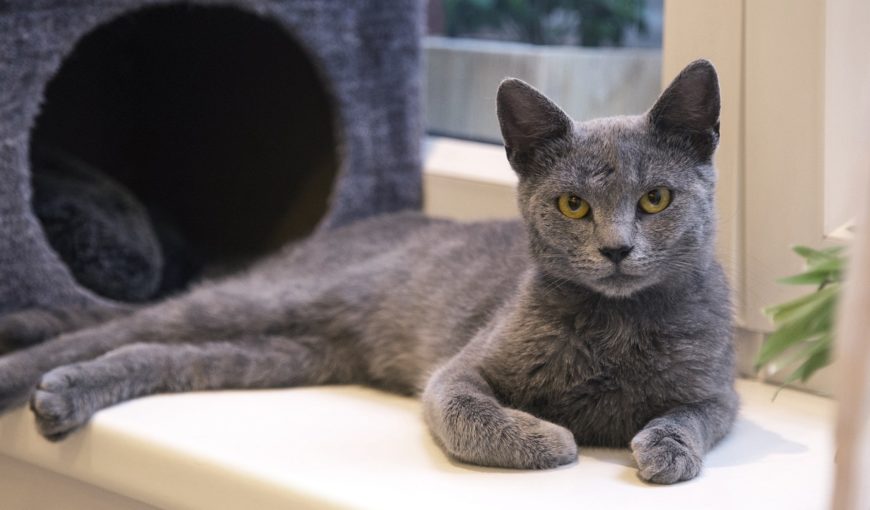The Feline Distemper Vaccine

Even though the yearly vaccination for cats is commonly called a distemper vaccine, there really isn’t a feline version of the disease that causes canine distemper. The name comes from the fact that when vaccinations for the common serious cat diseases became available, they were compared to a dog getting its distemper vaccine, so the name feline distemper stuck.
The feline distemper vaccine is abbreviated FVRCP and the FVR component of the vaccine stands for Feline Viral Rhinotracheitis which is an upper respiratory or pulmonary infection caused by feline herpesvirus 1. This virus causes over one half of the respiratory diseases in cats and can be found worldwide. FVR is very contagious and can cause severe disease, including death from pneumonia in young kittens.
The virus is shed in saliva and eye and nasal secretions and can also be spread by objects such as clothes, shoes, food and water bowls, blankets and toys. FVR has a two-to five-day incubation period. The virus is shed for one to three weeks post-infection. Carriers will shed virus intermittently for life.
Initial signs of FVR include coughing, sneezing, nasal discharge, conjunctivitis, fever, and loss of appetite. These usually resolve within four to seven days, but secondary bacterial infections can cause the persistence of clinical signs for weeks.
More severe cases may require supportive care such as intravenous fluid therapy, oxygen therapy, or even a feeding tube. Conjunctivitis and corneal ulcers are treated with topical antibiotics for secondary bacterial infection.
Feline calicivirus, which is the “C” in FVRCP is a virus that causes serious disease in cats. Calici can be isolated from about 50% of cats with upper respiratory infections and is extremely common in crowded conditions such as catteries and shelters.
FCV replicates in the oral and respiratory tissues, and is secreted in saliva, feces, urine, and respiratory secretions. It can be transmitted through the air, orally, and on objects like shoes, bowls and toys.
Infected cats usually shed the virus for two weeks. Following this period, infected cats may never shed the virus again or can become latently infected and shed the virus continuously or intermittently. Co-infection with either feline herpesvirus or feline AIDS causes a more severe disease.
Acute signs of FCV include fever, conjunctivitis, nasal discharge, sneezing, and a severe mouth infection called stomatitis. Pneumonia may develop with secondary bacterial infections. In addition to stomatitis, some cats may develop painful polyarthritis.
Cats may be infected but will not show symptoms until the cat is stressed, such as at the time of adoption.
There is no specific treatment for FCV. Antibiotics are used for secondary bacterial infections. Nursing care and rehydration are used for dehydrated and anorexic cats. Stomatitis is very difficult to treat and sometimes requires lifelong care.
The “P” in FVRCP stands for Feline Panleukopenia virus, which is caused by feline parvovirus, a close relative of canine parvovirus. Once contracted, it is highly contagious and can be fatal to the affected cat.
Panleukopenia is primarily spread through contact with an infected animal’s bodily fluids, feces, or other objects, and can be spread long distances through contact with bedding, food dishes, or even by clothing and shoes of handlers of infected cats. Panleukopenia is also spread by fleas.
The virus primarily attacks the lining of the gastrointestinal tract, causing internal ulceration and, ultimately, total shedding of the lining of the intestines. This results in profuse and usually bloody diarrhea, severe dehydration, malnutrition, anemia, and often death. It causes a decrease in the cat’s white blood cells, thus compromising its immune system. Other symptoms include, lethargy, loss of appetite, fever, vomiting, and loss of skin elasticity due to dehydration.
Most panleukopenia deaths are due to secondary infections or dehydration resulting from diarrhea. This is because the virus affects the infected cat’s immune system, leaving it vulnerable to secondary infection.
Feline panleukopenia requires aggressive treatment if the cat is to survive, as this disease can kill cats in less than 24 hours. Treatment can involve hospitalization, whole blood transfusion, intravenous fluids, injections of vitamins, and antibiotics.
Feline panleukopenia and canine parvovirus are extremely closely related, but the viruses cannot be transmitted between dogs and cats.





